Samsung Freestyle 2022 – the portable projector in the round (AV review)
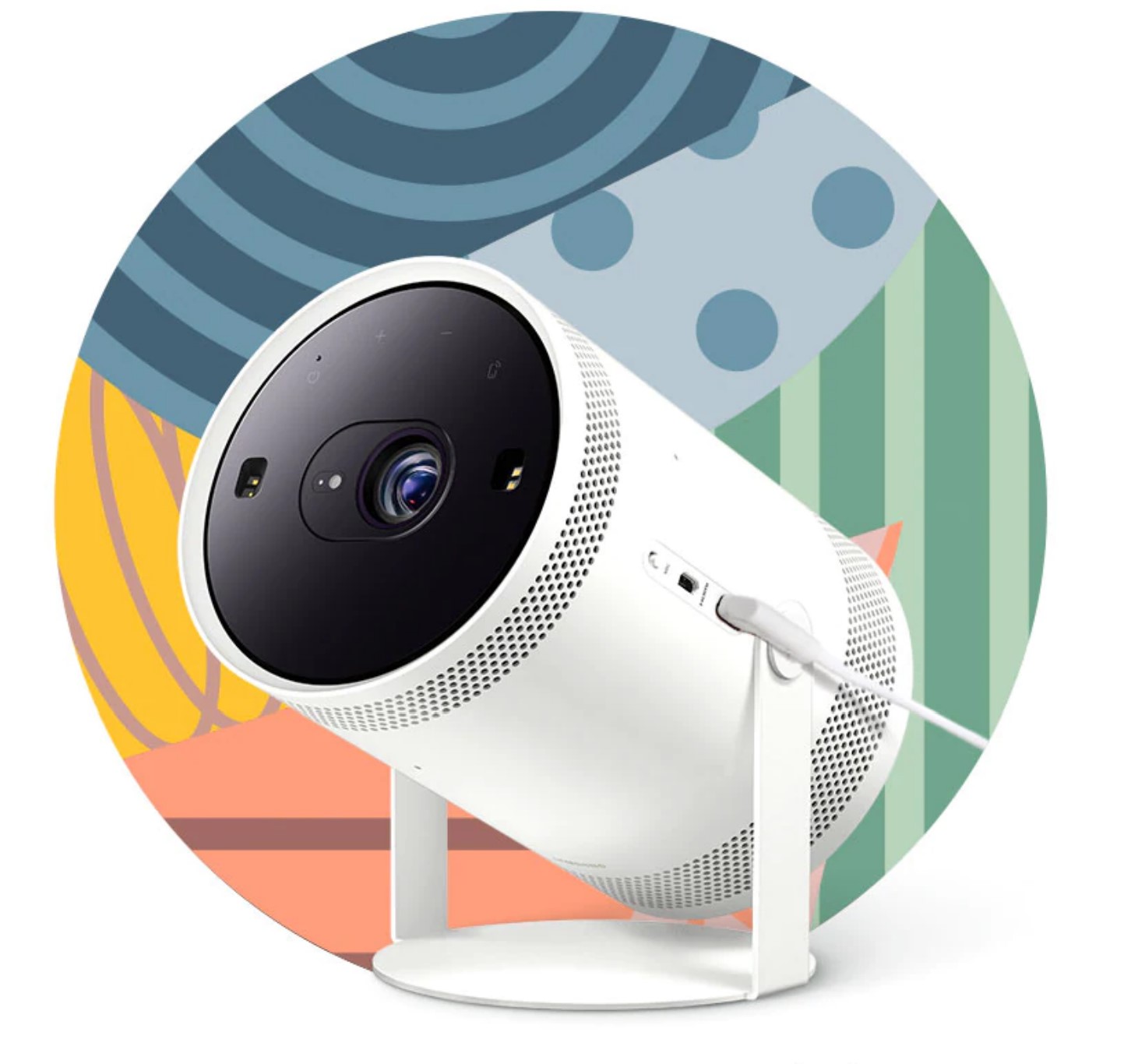
The Samsung Freestyle is a lightweight, compact projector that can cast a 1920 x 1080 image on up to a 100″ diagonal screen. The stand gives you 180° rotation, while the automatic image adjustment corrects for tilt, focus and scaling.
It is for grey nomads (any colour really😂), kids, sports fans and more that may consider portability more important than image quality – although the latter is commensurate with this new breed of LED laser projectors.
But as with all mini-LED (Pico) projectors, you need to know if what you are buying meets your needs in terms of brightness, ambient light control, screen size, screen type etc.
We will endeavour to explain using the Samsung Freestyle as the base example. Forgive us if we appear harsh. This is a top-end price for a 1080 projector, and we want to see if its performance justifies that.
Samsung Freestyle 2022 Model SP-LSP3BLAXXY (series 3)
| Website | Product Page |
| Price | $1295 |
| Colours | White, but you can buy skins for Blossom Pink, Forest Green, and Coyote Beige |
| From | Samsung approved retailers Harvey Norman, Domayne, Bing Lee, Videopro, and Officeworks. |
| Warranty | 12-months ACL |
| More | CyberShack Samsung News and Reviews |
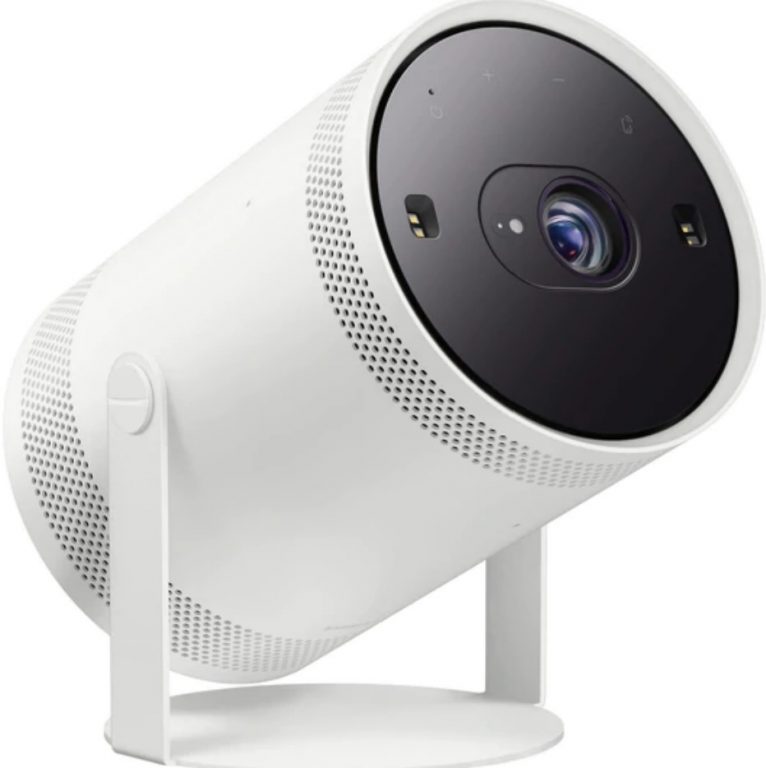
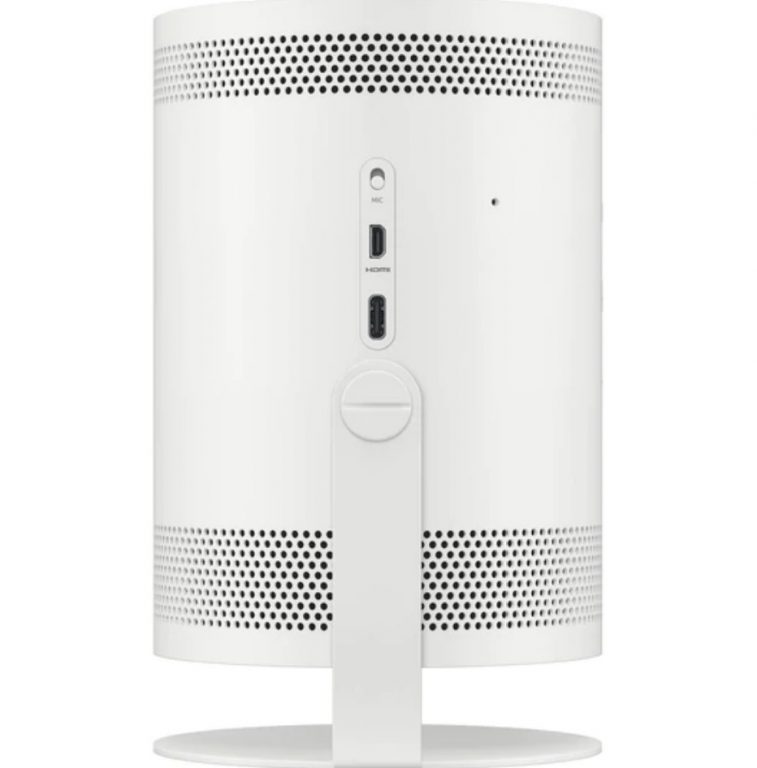
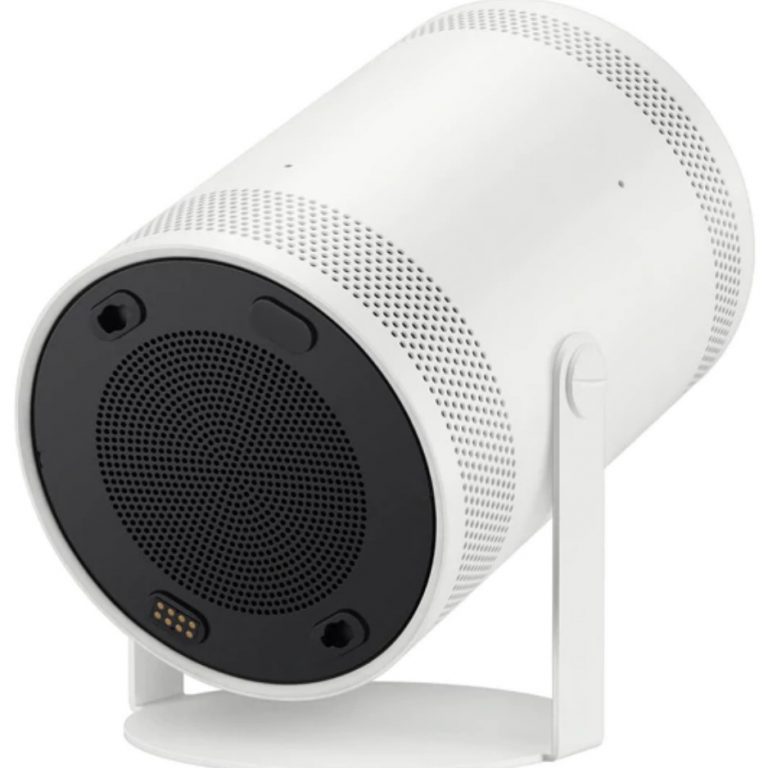
We use Fail (less than expected), Pass (meets all expectations) and Exceed (better than expected or class-leading) against the main headings.
First impression – small and cylindrical like a spotlight – Exceed
The Samsung freestyle is an unusual format – the 171.4 (H) x 95.2 (Round) mm x 800g cylinder allows for vertical and horizontal use – and every angle in between as it has a digital auto-keystone correction to square up the image.
As well as the mini-HDMI 1080p@60Hz ARC compatible port (adapter not supplied), it has the Samsung Smart Hub TV operating system. Connect to Wi-Fi, and it is a digital TV. It has all the digital free-to-air channels, a range of streaming channels (Netflix and Amazon Prime certified), AirPlay2, Samsung TV Plus ad-supported TV content, and a range of utility apps – the same as any 2022 Samsung Smart TV.
It also has Wi-Fi 5 AC for Remote Access, so you can run Microsoft 365, Samsung DeX, Miracast (Wi-Fi direct) or AirPlay2 (not Chromecast) and more, making it a great work from home or even a boardroom projector (with caveats). It has a far-field mic (and mute switch) for Alexa and Bixby voice assistants and an IR remote control.
And it has Bluetooth 5.2 for screencast and can connect BT HID devices like a mouse, keyboard, or speaker.
You can control some projector features from the Samsung SmartThings app. This includes smartphone-based auto-calibration, grayscale, and gamma calibration – but Joe and Jane Average will never use that.
Power is from a 65W USB-C charger. The USB-C port does not play audio or video content but supports power from a power bank.
The 134-page manual (a ZIP file, so after extracting, select the ENG . PDF version) indicates the range of features.
Setup – Pass
You can choose to use a Samsung smartphone and the SmartThings App or manually via the remote. We chose the latter as we wanted to see the step-by-step setup. We later tested the SmartThings setup – it is easier, but you need a Samsung smartphone or tablet and a Samsung account.
Essentially it requires Wi-Fi 5 AC (2.4 or 5Ghz preferred), agreement to Samsung policies (optional agreement to Advertising as part of Samsung TV Plus), update firmware (about 20 minutes), and you are away.
Out of the box, the auto-keystone correction did not work, and during setup, it reversed the image (mirror). Rebooting cured the image reverse, but we could not get auto-keystone working (more later).
OK, let’s talk about mini-LED Pico projectors (using the Samsung as the base)
There are a plethora of projectors using this new LED DLP projector technology. These use a Red, Green, Blue (RGB) LED light source, a spinning colour wheel (RGB plus White), and in this case, a .3” Pico DMD Active 960 x 540 mirror that displays four pixels on the screen every frame, e.g., 1920 × 1080 pixels. It is not true 1080p that you get from an LCD projector because the imager is dithered.
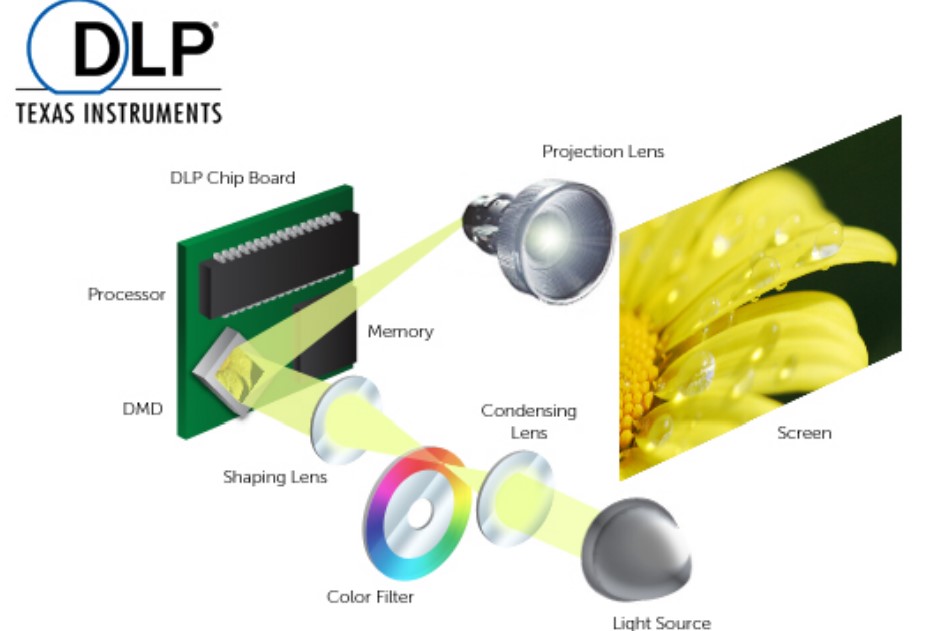
Other electronics include the power supply, HDMI interface, Digital Signal Processor, speaker/amplifier, RAM/ROM, and the TV operating system.
Brightness – Pass (for darkened rooms only)
Samsung claims a 550 LED lumens brightness (measured at the LED). This is not an actual measurement of light at the optics (ANSI) or light at the screen (nits). It just looks like a far more impressive figure.
This is equivalent to 230 ANSI Lumens (a more common projector measurement).
However, that is still not the brightness at the screen (depends on the distance to the screen), which is measured in nits (candelas per square meter) or a maximum of 67 nits at 100” (note that these measurements are confirmed by Projector Central which has more professional-grade measurement equipment than we do).
According to Texas Instruments (PDF), minimum image brightness (at the screen – not the LED or lens)
| Dark Room | Dim Room | Lit Room | Bright Room | Outdoors | |
| Environment | All lights turned off <40 lumens | Soft lighting at night <300 lumens | Office Light 400-800 lumens | Well-lit room with windows and indirect daylight 1000-1600 lumens | Indirect sunlight (shade) 1800+ lumens |
| Suggested image brightness at the screen | 50 nits | 100 nits | 200 nits | 300-400 nits | 600+ nits |
The Samsung Freestyle produces enough brightness for a dark room.
Contrast – Pass
Contrast is the ratio of white to black – how much brighter white is than black. The ratio drops steeply if you don’t have pure black (more of a grey). Samsung says it is HDR (High Dynamic Range capable), but it simply downmixes HDR content to the projector’s SDR capability. Why? Three contrast measurements defeat HDR.
The first two are Dynamic contrast and Full On/Off contrast – both are notoriously misleading. The only accurate measurement is at the screen (depending on the screen’s distance).
Samsung quote 100,000:1 Dynamic Contrast. An iris (like the pupil in your eye) regulates the light output. In dark scenes, it reduces the light to make blacks look blacker and vice versa for light scenes. It then measures the difference between the darkest black in any scene and the whitest white in another scene. It is not an apple-for-apple measurement.
The theoretical Full-On/Off (FOFO) contrast is a projection optics measurement, and, in this case, it is about 25,000:1 – still a nonsense measurement.
These are nowhere near the reality of the screen contrast (estimate 500:1), which is what your eyes see. In theory, it will support HDR (the lowest level), but in practice, no.
Screens have a lot to do with it to
A significant issue affecting all low-powered mini-LED projectors is the projection surface. Painted walls and cotton sheets absorb light (negative gain sucks the life out of the image). Some projectors have settings for different wall colours – this does not. If you want the best image, you need to buy at least a neutral gain screen – for every lumen it receives; it reflects a lumen. We test on a 1:1 off-white satin surface.
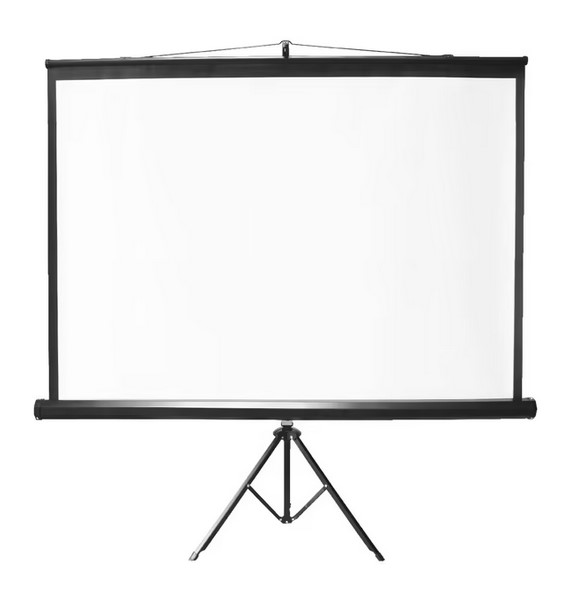
A tripod-mounted 100” 1:1 portable screen is $198 from Officeworks.
Screen distance has a lot to do with real brightness and contrast
Samsung has a projection ratio of 1.2:1. In other words, a 1.2m distance from the screen produces a 1m (39.37”) diagonal image. Samsung rates the projector image size as 30-100” (76.2-254 cm).
For every 2x increase in the diagonal image size, projector brightness (lumens) needs to increase by 4x to maintain constant image brightness (nits). Put simply, the 100” diagonal image is four times darker than the 50” diagonal image. We tested a 55” image (due to space and light control issues), and the image is considerably brighter and more colourful than at 100″.
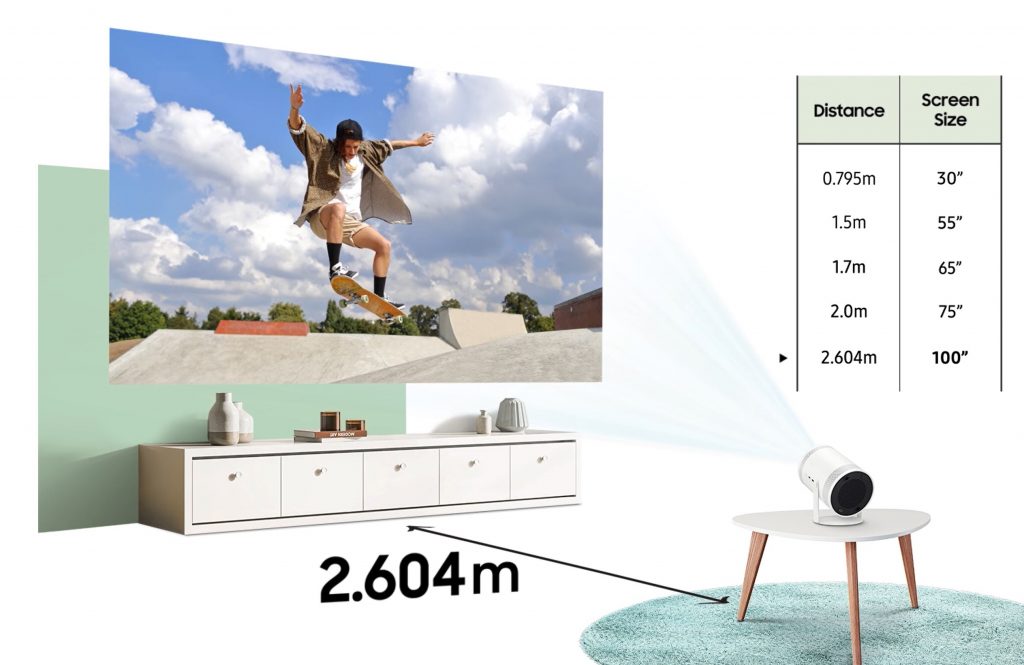
Automatic keystone correction – Fail
We experienced automatic keystone correction (squaring up the image) fail when changing modes (streaming, ambient mode) or orientation (ceiling, wall, distance). It appeared to work well at 90° (straight forward) or 180° (straight up) but not at any other angle.
We tested this over a few days, and unless the unit is faulty (and it could be), this is not satisfactory and is a deal-breaker. Manual adjustment was incapable of squaring up the image – this is the closest we could get on either setting.
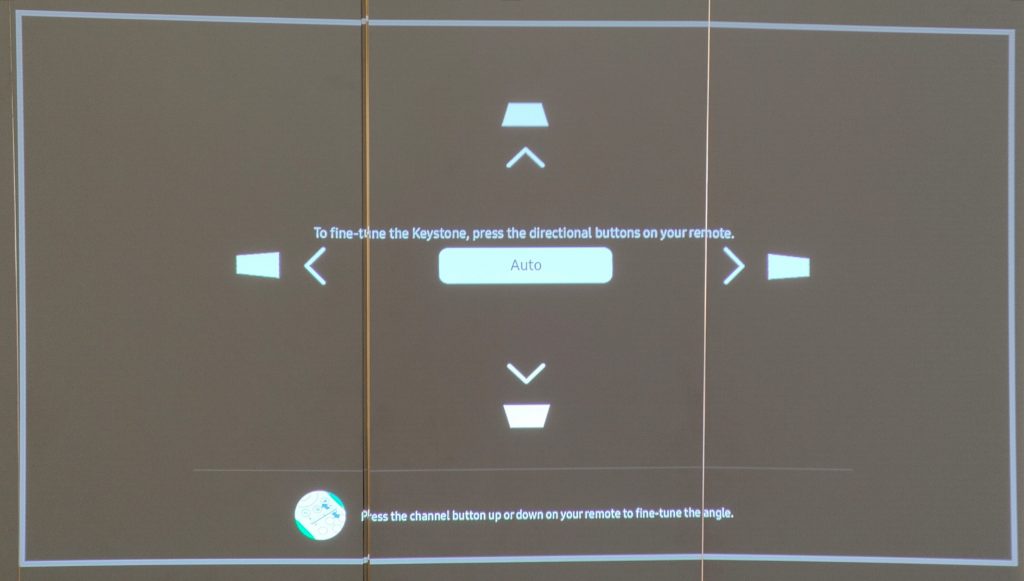
Ceiling viewing – Pass
Aussie homes typically use matte white ceiling paint reflecting about 80% of light. Still, because those ceilings are generally 2.4m and you are probably projecting from a 600/800mm high side table or desk, you only get a 55-65” image where brightness levels are way better.
Ambient mode – Pass(able) in dark rooms
It has 20 custom lighting options and visual effects, or you can use your photos. The real issue is not the operation, but this is largely useless in a typical ambient office or daylight room. Image Left – <40 lumen room and right 400 lumen room.
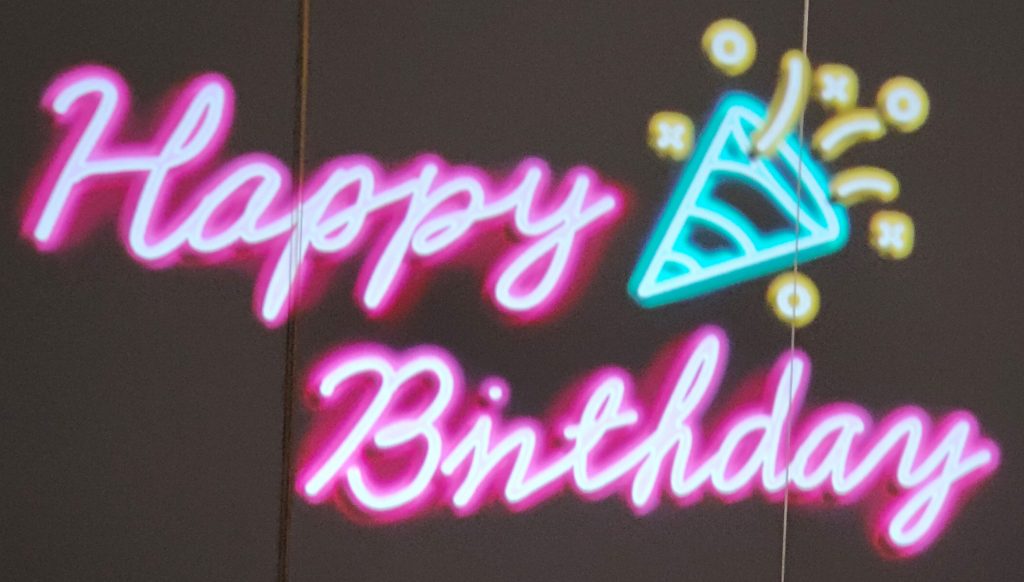
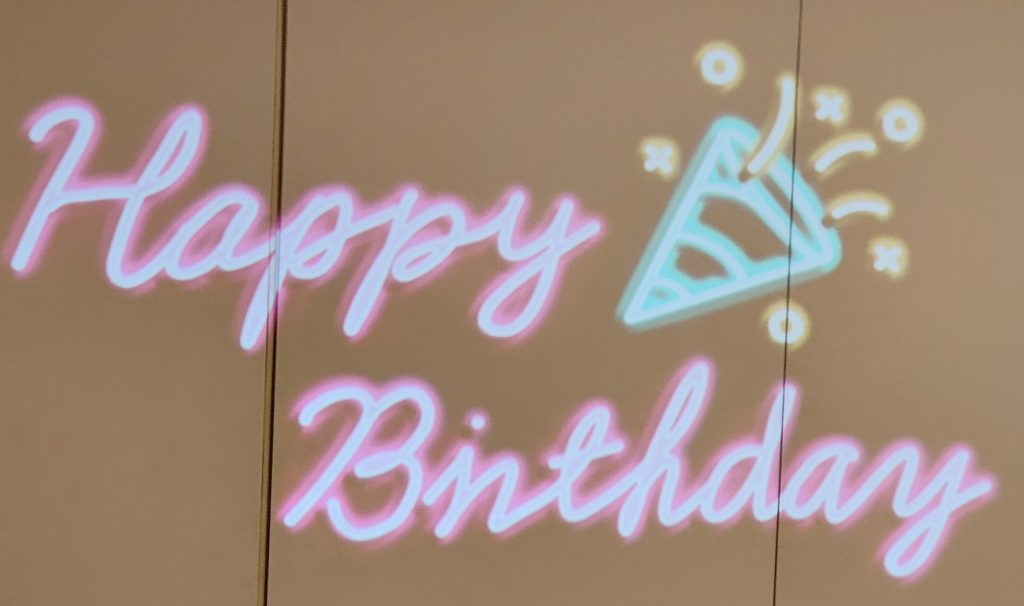

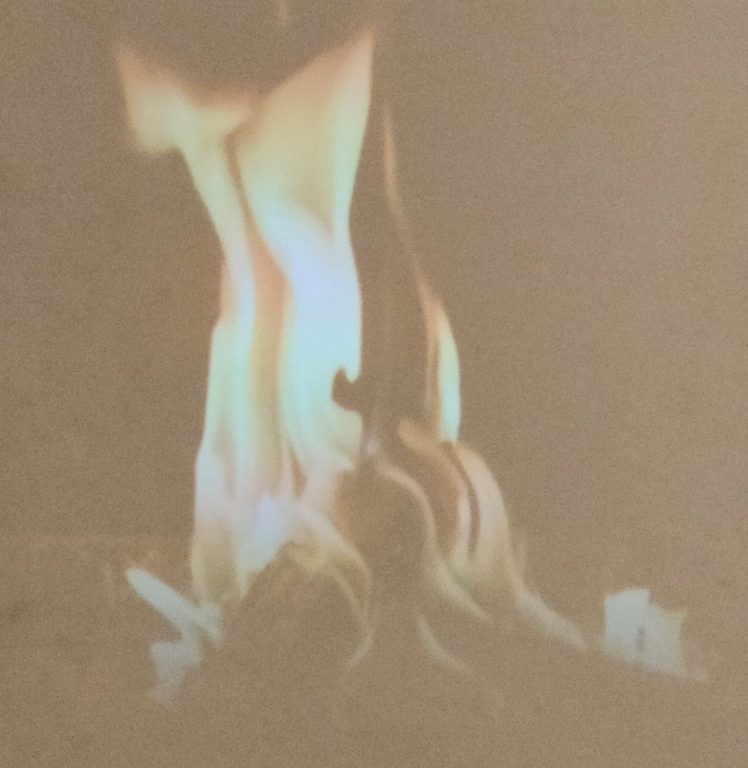
Resolution downscale – Fail
The HDMI input will only accept 1920 x 1080i or 1280 x 720 content. There is no 4K signal downscale. It only supports 16:9 images.
Video Pre-sets – Pass
It has Dynamic (the brightest), Standard (default), Movie, and Game. The latter increases brightness to Dynamic and reduces latency by disabling most of the ‘smarts’.
Dynamic has a more colour-saturated image and a cooler blue cast (about 7000° Kelvin cool white). It is less colour accurate and reduces details in the highlights and lowlights. But people love saturated colours.
Standard mode is slightly more colour accurate (about 6000° Kelvin daylight white), still not close to 100% sRGB or DCI-P3 colour gamut as brightness is too low. However, you can ramp that up for perhaps the best overall viewing experience.
Movie mode (about 5000° Kelvin closer to warm white) is, in our opinion, not useful unless in the darkest of rooms, and then you need to increase the brightness to 100%.
Sharpness and motion – Pass
The image is quite sharp (auto or manual digital focus), and the motion scenes are relatively smooth (Samsung call this Auto Motion Plus, and it inserts black frames between each actual frame). Here we found that the 100” screen was less than the optimal size. It is way better at 55-65” – brighter, crisper, and the image has a little ‘punch’.
Sound – Pass
It has a 5W mono 360° speaker (sound emanates from around the base). The device can decode PCM mono/stereo and Dolby Digital Plus (5.1 surround) and downmix to the single speaker. You can use Bluetooth to connect an external speaker or soundbar. The manual mentions Dolby Atmos, but that would still downmix to the mono speaker.
It gets quite loud at 80dB – not room-filling but more than enough. The sound signature is almost neutral, and the onboard EQ (buried in settings) could help increase clear voice from 1-4kHz.
Mid-bass starts from 70Hz, building through high bass (100-200Hz) before flattening at 250Hz, where the response is pretty flat to 5kHz with a gradual decline to 20kHz. The sound gets a little choppy (clips or compressed peaks) at full volume, so back of 5dB, and you are fine.
The 360° speaker comes out the ‘bottom’ of the cylinder, so it is not really ‘in the round’, especially if you use it to project on a wall. You also need to ensure space between it and the surface if you project to the ceiling, or the sound will be muffled.
You can read more about sound signatures How to tell if you have good music (sound signature is the key – guide.
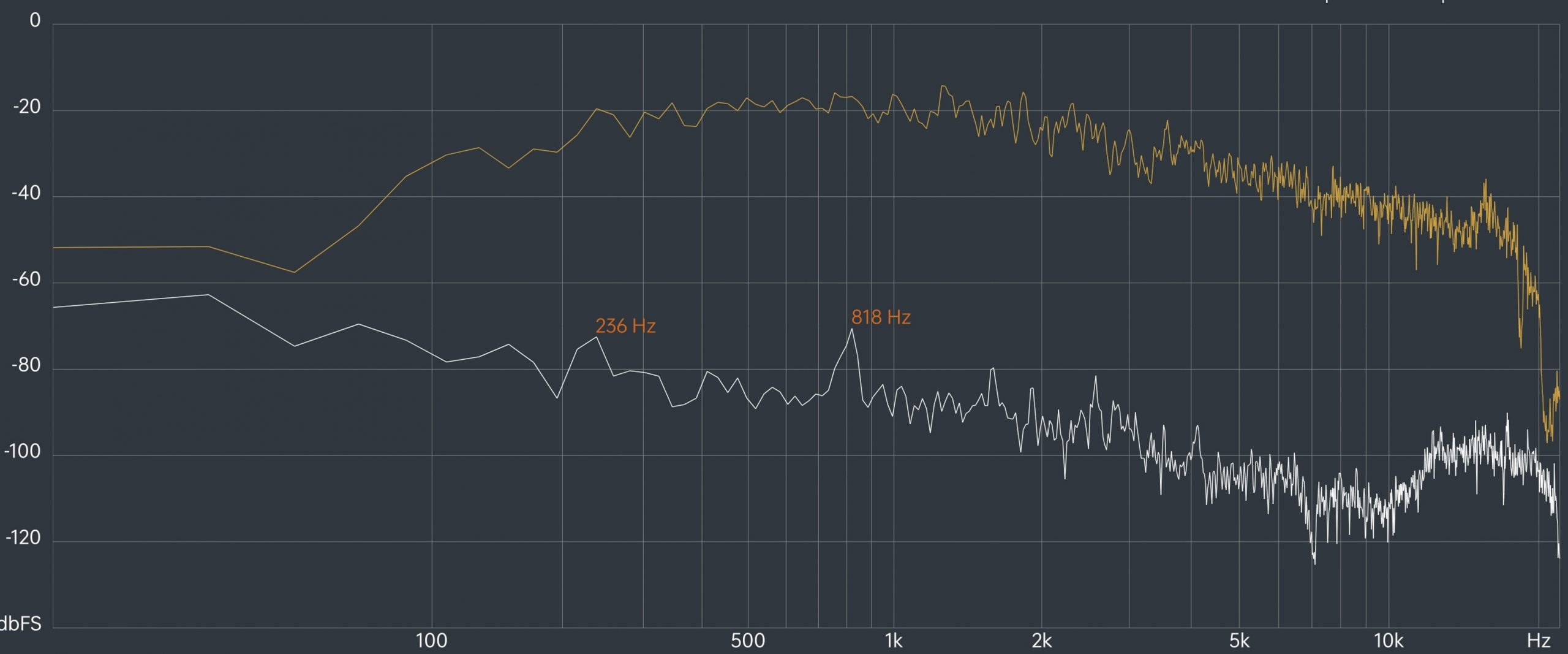
Summary: Pretty good neutral signature with just enough bass to satisfy and just enough treble to add a feeling of ‘air’.
Noise – Pass
Samsung claim 30dB(A), which is correct – it has a mild fan noise if you listen closely.
Power
The USB-C charger has PPS output from 5-20V/3.25A or a total of 65W. The unit requires a minimum of 20V/2.5A/50W, and you can use any 50W+ USB-C PD charger and the supplied 3W USB-A to USB-C cable.
Tests _ Samsung Freestyle
The first of each image is a <40-lumen room (dark), 100% brightness gives an acceptable image, colours are saturated (dynamic settling), but the is little definition in the highlights or shadows. The light meter shows the room at 8 lumens and the screen at 75 nits. Note the keystone issues – the camera used a framing grid on a tripod located 50mm above the Freestyle
The second of each image is a 200-lumen room (standard home lighting), 100% (10) brightness. The Light meter shows the room at 200 lumens and 45 nits at the screen.

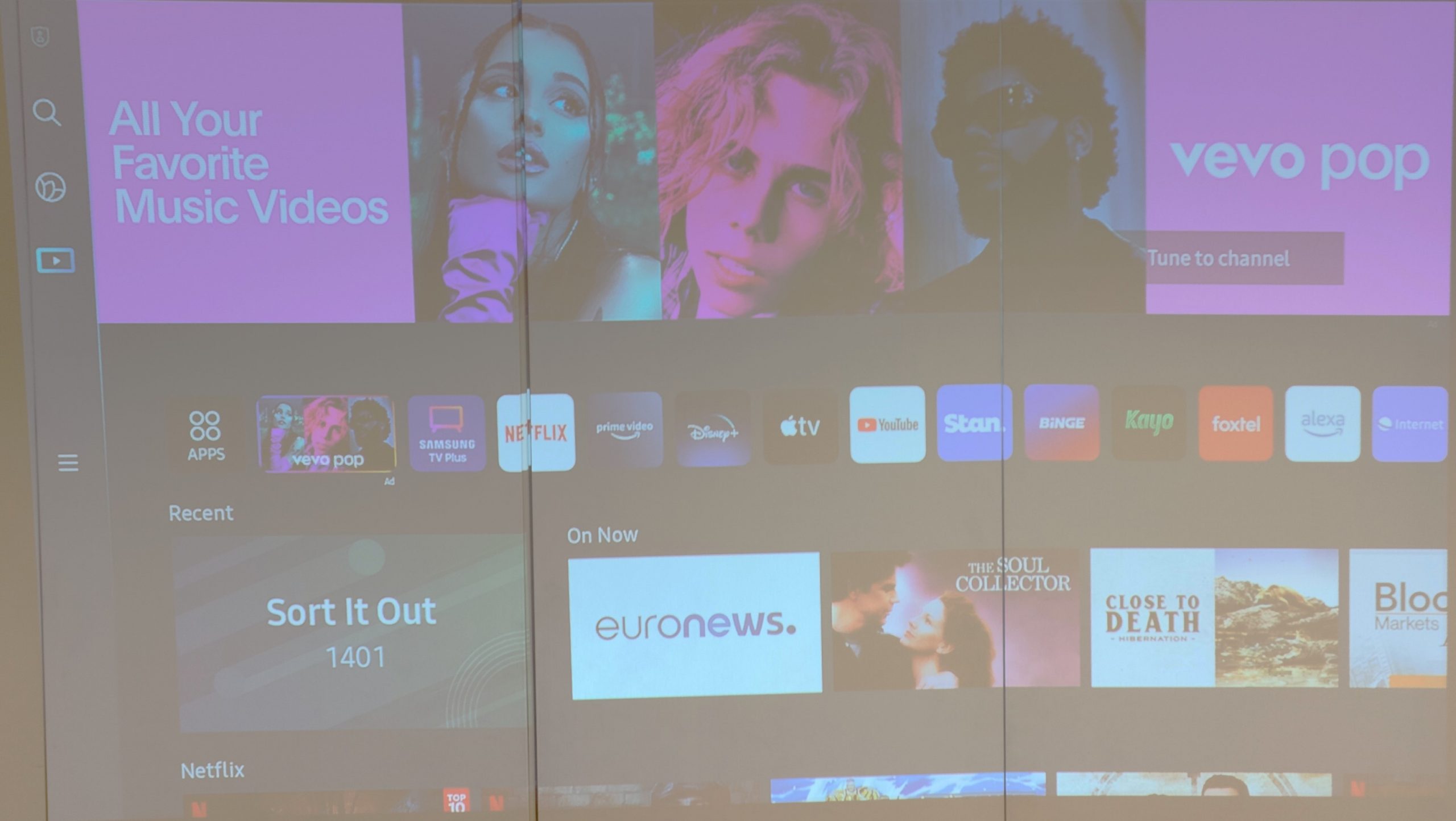

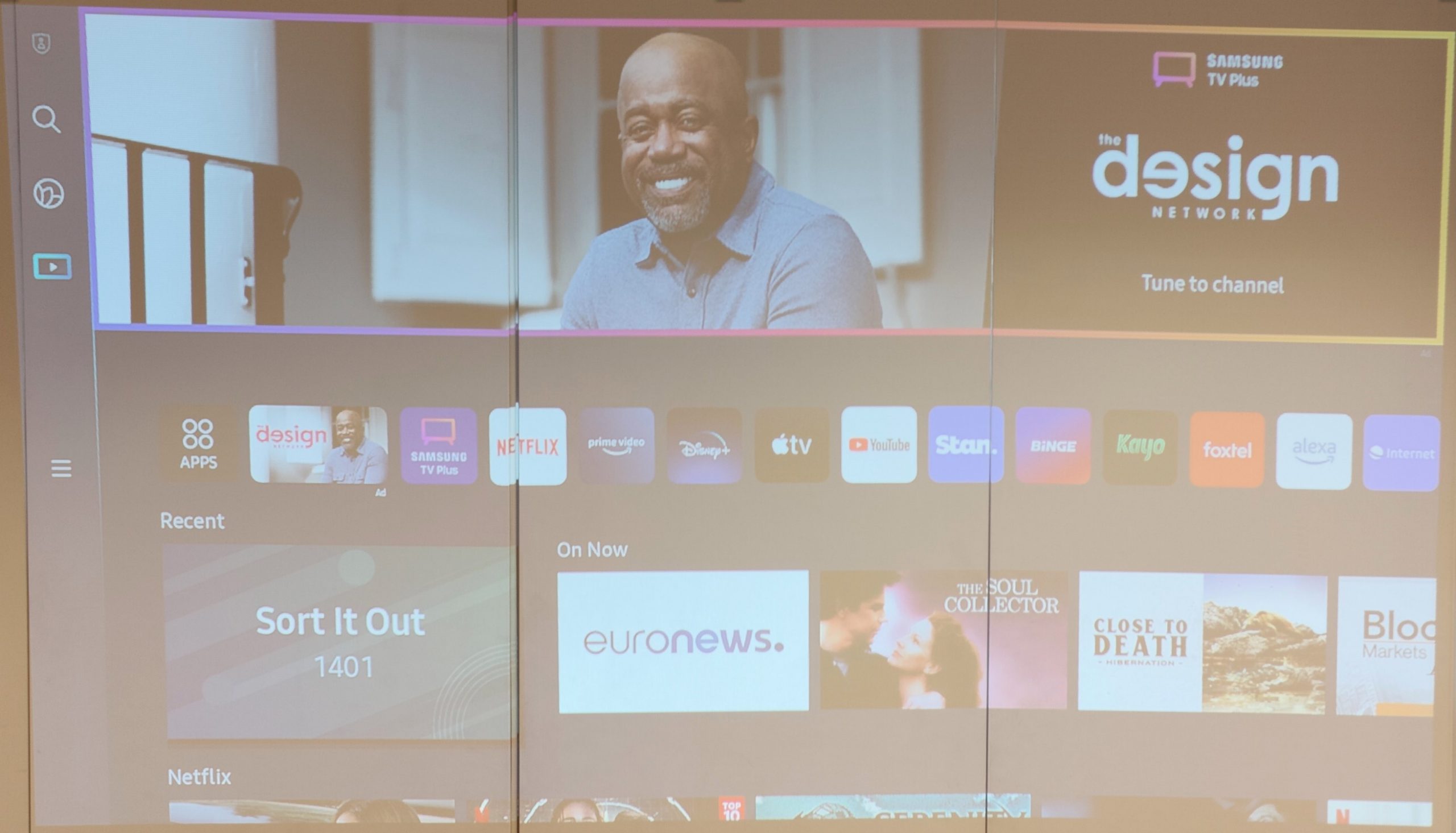
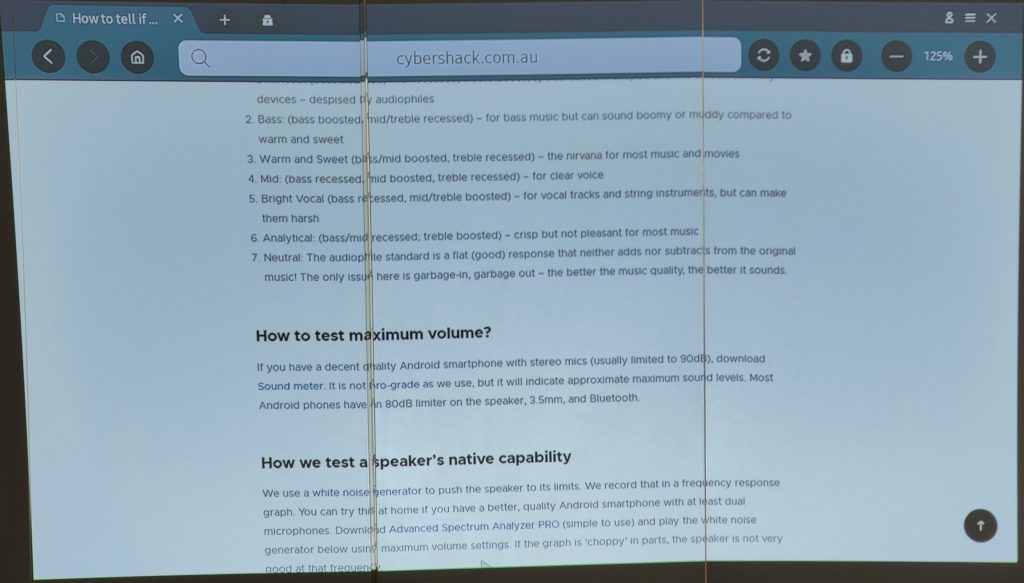
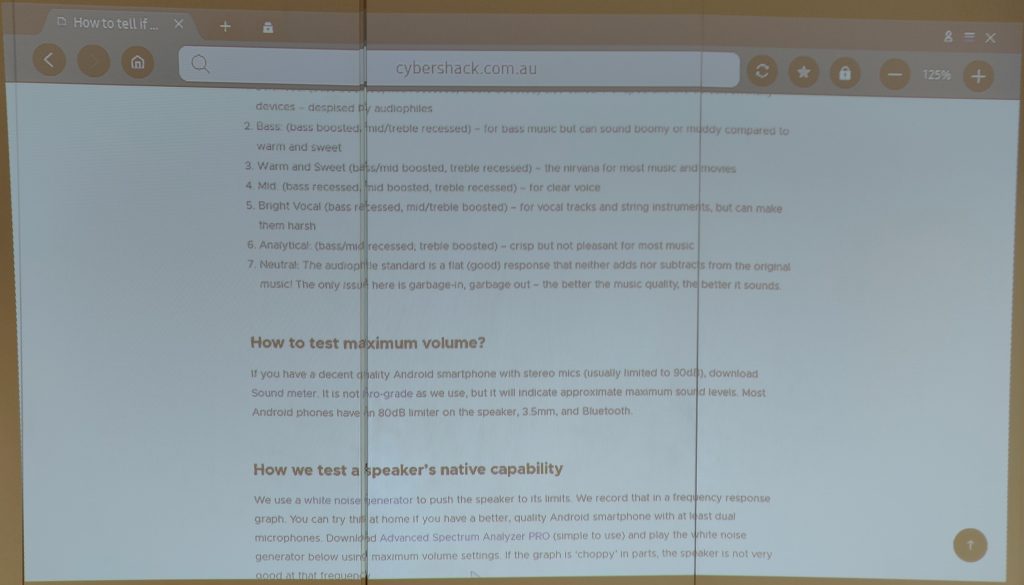
Maintenance – Pass
Like all mini-LEDs, it has a useful life of 20,000 hours depending on brightness. But that is about seven years at eight hours a day. The LED is not replaceable – you throw the device away.
Privacy – Fail if you let it
Samsung wants to monetise (not sell) your data – whether via a smartphone, tablet, or smart projector. If you sign in to the Samsung account, it has all your use, e.g., time, content, location, Wi-Fi network and vast amounts more it aggregates from other Samsung devices you use. The main issue is that you cannot use this device without signing into your Samsung Account.
Now we are not saying we don’t trust Samsung (or Google that requires a Gmail account to use Android). Still, if you want privacy, you need to agree to as little as possible, reset your advertising ID and preferably use a junk email address that does not link to your regular email account. Never log in using Facebook or other social media.
You can read how to set up a junk email address here. ABC iView wants your data from 15 March – fight this at any cost. Use this for all streaming logins, Samsung account, internet loyalty and other transactions.
CyberShack’s view – The Samsung Freestyle is one of the better and more expensive projectors, but it is still for darkened rooms.
CyberShack dislikes marketing hype, and frankly, Samsung paints an unrealistic picture of 100” big-screen experience with crystal-clear, brilliant picture quality, and 360° rich, powerful, immersive sound.
In small print is the disclaimer, ‘Picture quality is dependent on environmental factors such as wall surface, room brightness, source quality and more. For best results, recommend projecting on a flat white or bright monotone wall in a dark room. Audio quality and performance may vary depending on environmental characteristics (e.g., room size, product placement and ceiling height) and quality of source content). Image simulated. Cable not shown’.
Judging from buyers’ comments (on Samsung and other websites), the hype is far from reality. Our summary is an acceptable image at 55-65” in a <100-lumen room.
This is a unique lifestyle projector for casual viewing. Most users will find the default picture settings acceptable. Few will use the Samsung SmartThings auto-calibration feature or pay for professional calibration. This is a shame as the device is capable of better out-of-the-box colour in a fixed room type (ambient brightness and screen type).
Nowhere is ‘you get what you pay for’ truer than with projectors. Pico LED projectors start at a few hundred dollars and top out at $1295 for this. As you pay more, you get better speakers, built-in Samsung (Google TV or similar) and 1920x1080p resolution. Its one of the best with caveats.
So, let’s look at the (not so) bright side. Completely darken the room, and the colours and brightness are more than acceptable (not picky, but they are a long way off an LED/LCD TV).
Samsung Freestyle, Samsung Freestyle, Samsung Freestyle
Samsung Freestyle 2022 portable mini-LED projector
$1259Pros
- Interesting portable design
- USB-C or 20V/2.5A/50W or more capable power bank power sources
- Reasonably ‘appealing’ image out-of-the-box
- Samsung Smart Hub TV and streaming services
- It can be used as a smart speaker, lamp, or Ambient mode to project photo gallery content
Cons
- Not colour accurate without SmartThings or professional calibration
- Nowhere near as bright and contrasty as advertised - for dark rooms only
- Auto-keystone adjustment failed
- Privacy can be an issue – Samsung knows all








